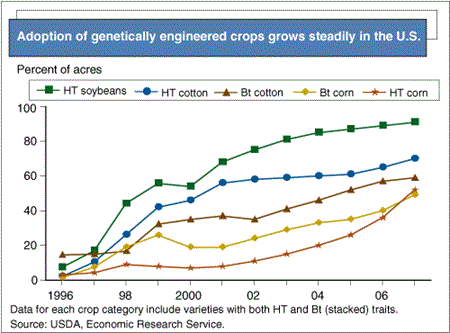U.S. Farmers Increase Adoption of Genetically Engineered Crops and Favor Multiple Traits - Amber Waves September 2007

U.S. farmers have rapidly adopted genetically engineered (GE) soybeans, cotton, and corn with herbicide tolerance (HT) and/or insect resistance (Bt) traits over the 12-year period following commercial introduction. HT crops tolerate certain potent herbicides, allowing adopters of these varieties to control pervasive weeds more effectively. In the U.S., adoption of HT soybeans has expanded faster and more widely than that of other GE crops, reaching 91 percent of soybean acreage in 2007. The second most widely adopted GE crop, HT cotton, was planted on 70 percent of cotton acreage.
Bt crops contain a gene from the soil bacterium Bacillus thuringiensis that produces a protein toxic to specific insects. Bt seed use is concentrated in areas with high levels of infestations of targeted pests, so acreage shares for Bt corn and cotton are lower than for HT soybeans and cotton and vary widely across States. Bt cotton, which controls tobacco budworm, bollworm, and pink bollworm, was planted on 59 percent of U.S. cotton acreage in 2007—ranging from 10 percent in California to 85 percent in Louisiana. Adoption of Bt corn reached a plateau during 1998-2002 because farmers who needed to protect their crops against the European corn borer had already adopted it. Expansion in adoption of Bt corn resumed again in 2003 with the introduction of a Bt variety to control corn rootworm. Acres planted with Bt corn varieties accounted for 49 percent of U.S. corn acreage in 2007.
A trend in recent years is the rapid adoption of crop varieties that include more than one trait (stacked traits). For example, corn varieties with both Bt and HT traits grew from 1 percent of corn planted acres in 2000 to 28 percent in 2007 while cotton varieties with stacked traits increased from 20 to 42 percent of planted cotton acres in the same period.
According to ERS research, U.S. farmers are benefiting economically from adopting these GE crops through higher yields, lower pesticide costs, and savings in management time. The impacts of GE crops vary with the crop, technology, pest infestation levels, and other factors.
Worldwide, more than 250 million acres of biotech crops with HT and/or Bt traits were planted in 22 countries in 2006, with the U.S. accounting for about 54 percent and Argentina, Brazil, Canada, India, China, Paraguay, and South Africa together accounting for nearly 43 percent.
Adoption of Genetically Engineered Crops in the U.S., by Laura Dodson, USDA, Economic Research Service, October 2023
The First Decade of Genetically Engineered Crops in the United States, by Jorge Fernandez-Cornejo and Margriet Caswell, USDA, Economic Research Service, April 2006


